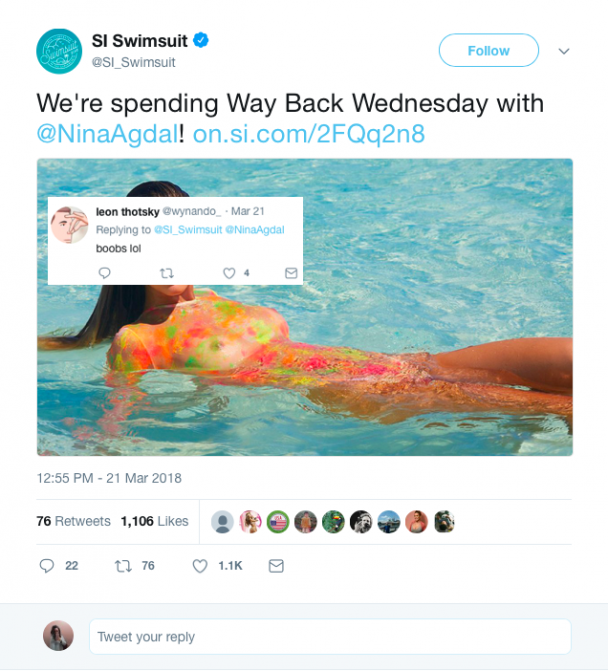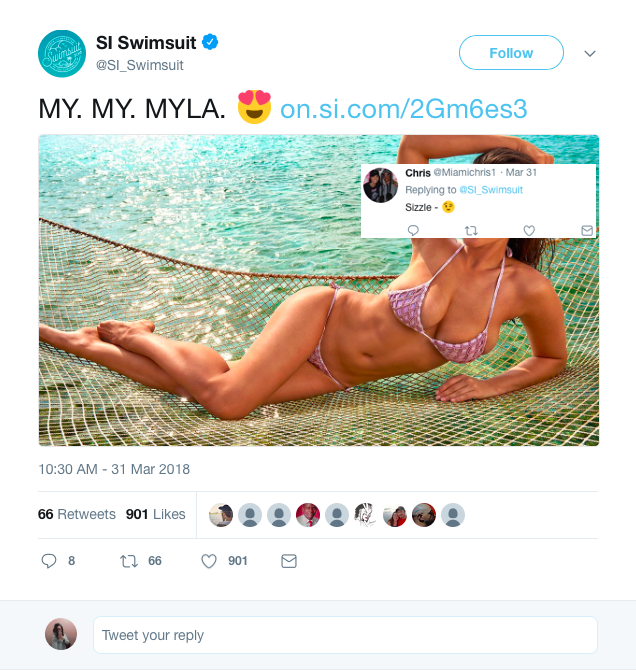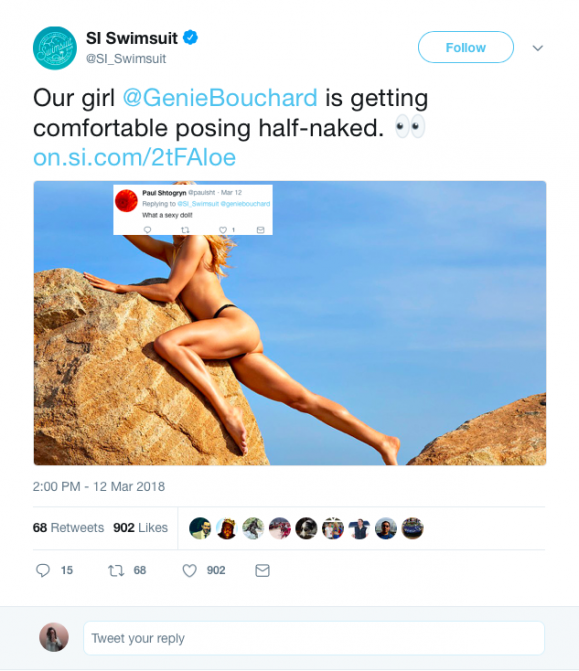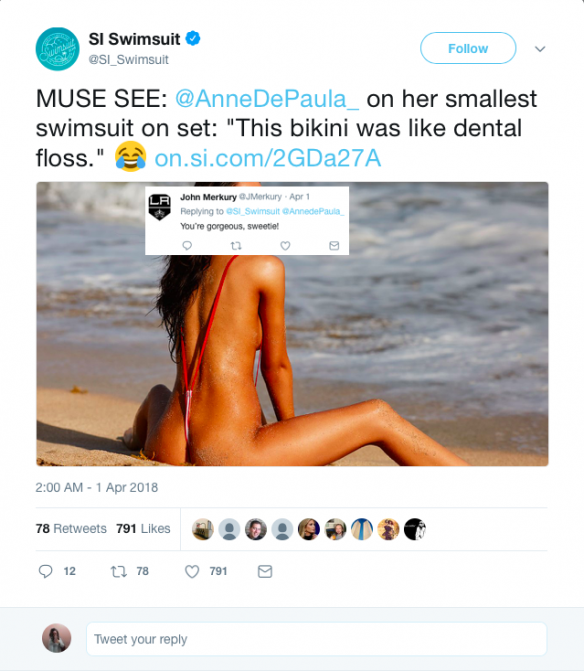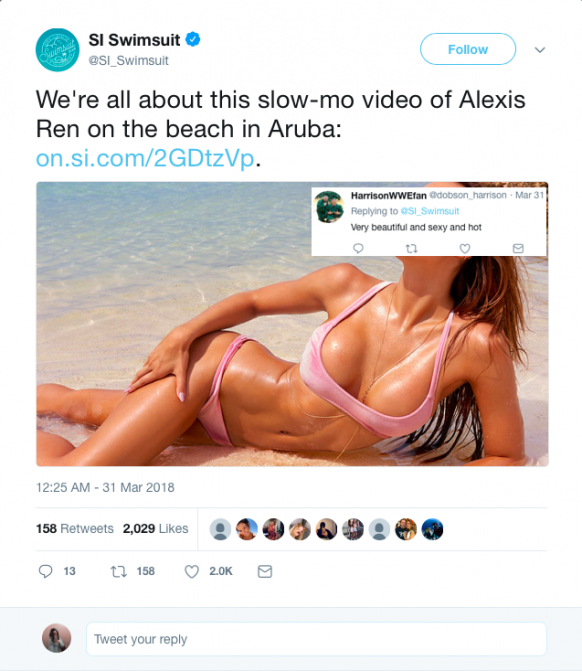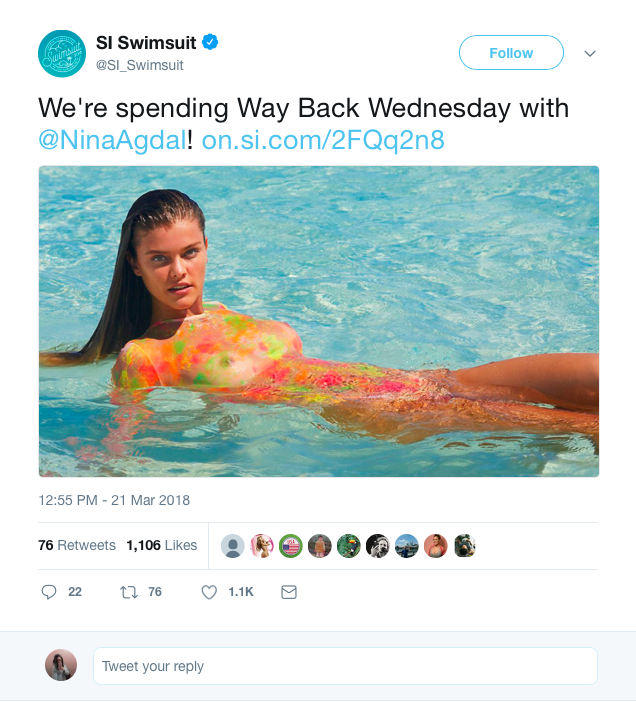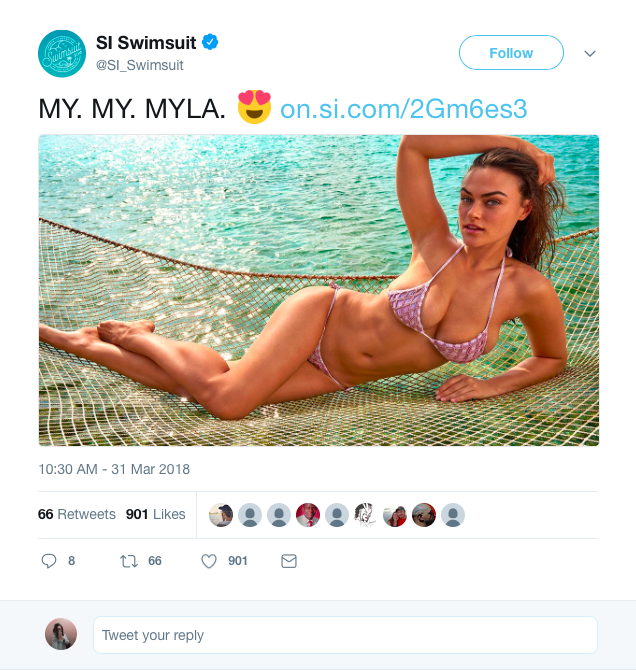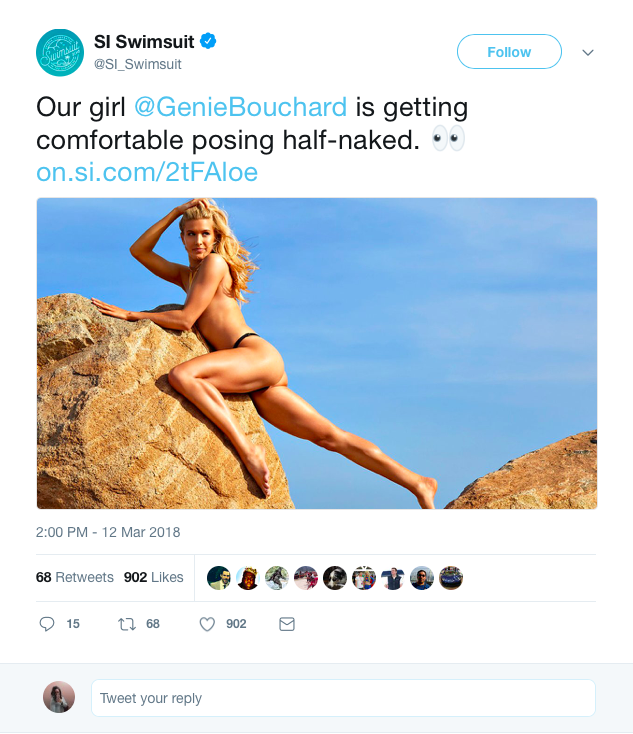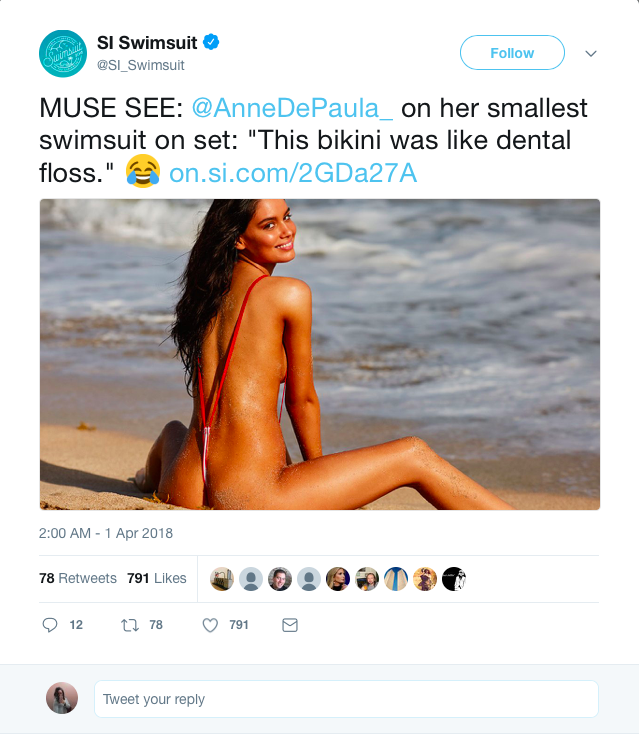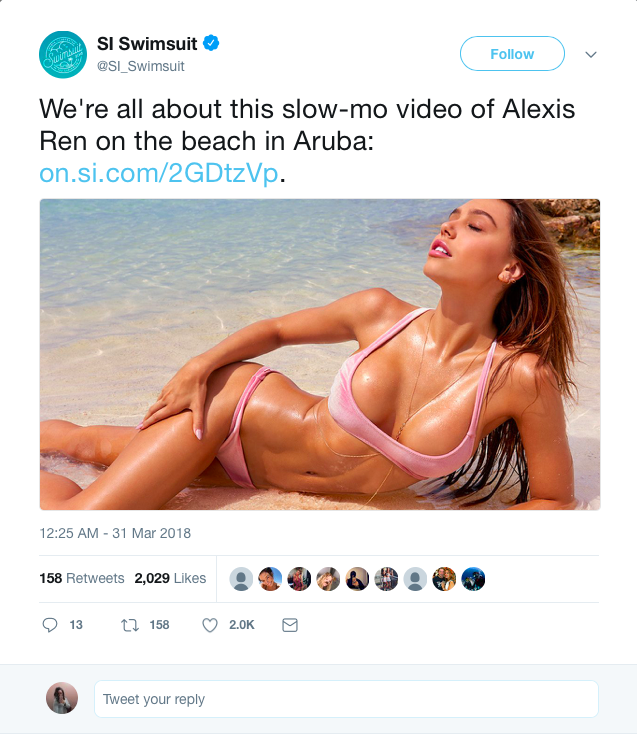Objectify Me!
by Sofia Ramirez
Introduction
When we’re scrolling through social media, how often do we stop and think critically about the images we see? While some of us are more accustomed to deep-reading things that appear on our timelines, there are many people who do not have the experience, the knowledge, or the tools to do so. These people tend to read images and text at a surface level.
By creating a photoset of collages, created from photos from the Sports Illustrated – Swimsuit (SI) online magazine articles taken from their Twitter account (@SI_Swimsuit) and people’s responses taken from the comments sections below the respective articles and photos, this photoset and essay work to examine the harmful effects of images and their captions, constructed through the lens of the male gaze, when internet trolls are able to access and interact with the images on Twitter. I will also be examining how social media platforms can encourage a negative or harmful dialogue within the platform itself.
I will first be discussing the theory and theory words that are the foundation of my ideas. From there, I will show my collection, followed by my explanation of the creative process and how the form works. I will then discuss other artists who have done similar works.
Theory
Internet Trolls
“Internet troll” is a term that describes people who post hateful or harmful comments online, targeting a person or a specific group of people (Bratu 89). As a result of surface-level reading, internet trolls do not often have the language or acquired knowledge to think critically about the things that are posted on social media, whether the posts be from personal accounts or corporate accounts.
Found Words
Found words are the words and phrases that are selectively chosen by other artists, and myself, in order to convey a message. As discussed below, Barbara Kruger and Betty Tompkins each use their own found words to send their politically charged messages to create an impact. My found words come from real Twitter users (internet trolls), who troll in the comments sections of SI.
The Male Gaze
The male gaze, as defined by Laura Mulvey, is a feminist lens through which film is constructed in order to invoke a sexualized way at looking at women that objectifies them and allows them to become objects of pleasure for men (833). Mulvey suggests that we not only need to identify when this occurs, but we also need to create content that publically calls it out and draws attention to it as a way of combatting the gaze – in her case, she proposes the idea of alternative cinema (834). While Mulvey’s area of focus is on film, her theory can also cross media boundaries and can be applied to other forms of texts, including the mashup of text and image that I’ve created here. One of the keywords Mulvey identifies is “scopophilia”, the concept of gaining pleasure from viewing the human body as an object (835). With my collages, I am drawing attention to how SI is using this concept to a) gain viewership, and b) to create capital, and to how Twitter, in allowing this content to be posted, is allowing a culture of female objectification to be not only tolerated but promoted and encouraged.
How do magazine companies benefit from creating images that perpetuate the male gaze? Is there a capitalistic gain?
By using social media as a means of allowing easier access to content, many companies create capital from the number of interactions, or impressions, their content is able to make online. The more people that click on, retweet, or favourite a tweet, the more capital the company is able to bring in. The more views a profile gets, the more likely it is that they will get increased sponsorship which leads to an increased number of clients or repeat customers. SI caters to men by posting scantily clad women in provocative poses, often with sexually suggestive captions or headlines. By catering to this large demographic, they are able to stay financially strong and will keep producing this content that their viewership has come to expect.
The Images Reimagined
Note – see Appendix for original images.
The Creative Process
I was selective about the text that I chose to put over the models’ faces because even though I want my viewership’s attention to be drawn to the grotesque nature of the comments, I also want them to look at my found words, to showcase how easily our language can be turned into something dangerous and violent in nature, and how Twitter offers a safe-space for online trolls to freely engage in this conversation. The comments I chose to include are short and simple, yet they fully encapsulate the male gaze and show how the original photographs and tweets were constructed to encourage the objectification of women.
How does the form work?
Twitter is cultivating a space where people can say whatever they want with little to no consequence. By keeping the original template of the tweet, I am calling out Twitter for fostering spaces where people can hide within the comments sections. The comments sections on Twitter are not visible when scrolling through your timeline – it is only visible when a tweet is expanded.
Who else has done art like this?
Barbara Kruger’s feminist collages raise awareness for women’s social issues and equity. The way she uses the Supreme-style font over photos is interesting because of the way she uses common language and a popular style to make such a politically charged art piece using only a few carefully chosen words to convey her message.
Betty Tompkins’ WOMEN Words, Phrases, and Stories collection contains several collages as well – she chooses her found words with great care, taking the derogatory or objectifying things men have said about women from real women. Many of these are aesthetically pleasing, even with the harmful words and phrases plastered on.
Both of these women take commonplace words and phrases and transform them into so much more, through their art – it is this that makes them so powerful, moving, and shocking.
Conclusion
I want people to be able to look at these pieces and engage critically with what they see. It is my hope that they begin to ask questions, such as, what happens when people post comments that objectify the women in the images? How does social media play a role in perpetuating negativity and objectification, and what does it do to us as spectators? To make people ask questions rather than to let them gaze blindly or shallowly is the ultimate objective.
Works cited
@AmerGigolo. “Lovely…” Twitter, 31 Mar. 2018, 1:47 p.m., twitter.com/AmerGigolo/status/980124316762279936.
Bratu, Sofia. “The Inexorable Shift Towards an Increasingly Hostile Cyberspace Environment: The Adverse Social Impact of Online Trolling Behavior.” Contemporary Readings in Law and Social Justice, vol. 9, no. 2, https://search-proquest-com.ezproxy.lib.ryerson.ca/docview/1973371989?pq-origsite=summon. Accessed 20 Mar. 2018.
@dobson_harrison. “Very beautiful and sexy and hot.” Twitter, 31 Mar. 2018, 2:28 p.m., twitter.com/Dobson_harrison/status/980134801570119680.
@JMerkury. “You’re Gorgeous, sweetie!.” Twitter, 01 Apr. 2018, 3:33 a.m., twitter.com/JMerkury/status/980332251878690816. Accessed 02 Apr. 2018.
Mulvey, Laura. “Visual Pleasure and Narrative Cinema.” Screen, vol. 16, no. 3, 1975, https://academic.oup.com/screen/article-abstract/16/3/6/1603296?redirectedFrom=fulltext. Accessed 10 Mar. 2018.
@paulsht. “What a sexy doll!.” Twitter, 12 Mar. 2018, 3:12 p.m., twitter.com/paulsht/status/973260476820934656.
Ramirez, Sofia. “ALEXIS.” 2018. .png file
Ramirez, Sofia. “ANNA.” 2018. .png file
Ramirez, Sofia. “GENIE.” 2018. .png file
Ramirez, Sofia. “MYLA.” 2018. .png file
Ramirez, Sofia. “NINA.” 2018. .png file
Stoeffel, Kat. “Barbara Kruger Forever: The essential artist talks Ikea, Trump, hypebeasts, sex, and power.” New York Magazine, 02 Feb. 2018, https://www.thecut.com/2018/02/profile-barbara-kruger-on-trump-supreme-and-harassment.html. Accessed 24 Mar. 2018.
@SI_Swimsuit. “MUSE SEE: @AnneDePaula_ on her smallest swimsuit on set: “This bikini was like dental floss.” https://on.si.com/2GDa27A.” Twitter, 01 Apr. 2018, 2:00 a.m., twitter.com/SI_Swimsuit/status/980308791026704384.
@SI_Swimsuit. “MY. MY. MYLA. on.so.com/2Gm6es3.” Twitter, 31 Mar. 2018, 10:30 a.m., https://twitter.com/SI_Swimsuit/status/980074778949189639.
@SI_Swimsuit. “Our girl @GenieBouchard is getting comfortable posing half-naked. on.si.com/2tFAloe.” Twitter, 12 Mar. 2018, 2:00 p.m., https://twitter.com/SI_Swimsuit/status/973242324288462848.
@SI_Swimsuit. “We’re all about this slow-mo video of Alexis Ren on the beach in Aruba: on.si.com/2GDtzVp.” Twitter, 31 Mar. 2018, 12:25 a.m., twitter.com/SI_Swimsuit/status/979922508337111040.
@SI_Swimsuit. “We’re spending Way Back Wednesday with @NinaAdgal! On..si.com/2FQq2n8.” Twitter, 21 Mar. 2018, 12:55 p.m., twitter.com/SI_Swimsuit/status/976487359658196994.
“WOMEN Words, Phrases and Stories: 1,000 Paintings by Betty Tompkins.” The FLAG Art Foundation, 2016, http://flagartfoundation.org/exhibitions/women-words-phrases-and-stories/. Accessed 24 Mar. 2018.
@wynando_. “boobs lol.” Twitter, 21 Mar. 2018, 12:55 p.m., twitter.com/wynando_/status/976487514457497600.
Appendix
PHOTOSET FOR COLLAGE NINA
PHOTOSET FOR COLLAGE MYLA
PHOTOSET FOR COLLAGE GENIE
PHOTOSET FOR COLLAGE ANNA
PHOTOSET FOR COLLAGE ALEXIS
Credits
These collages were produced for educational purposes as an assignment for ENG705 – Studies in Visual Culture.
These images are being used under fail dealing for the purpose of research and criticism and are provided solely for the purpose of research, private study, or education.
Creator: Sofia Ramirez. Image source: Twitter account @SI_Swimsuit.
© Sofia Ramirez 2018.

